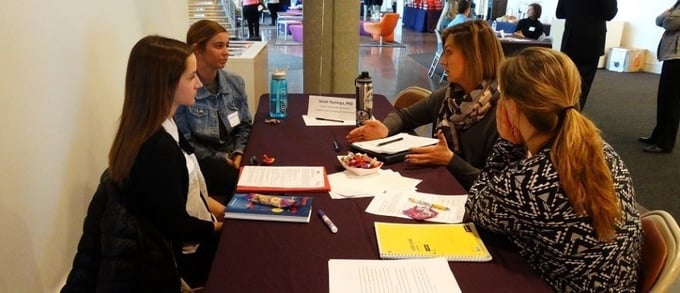A strong PLTW community – including students, educators, and supporters – is instrumental in reinforcing student learning and creating opportunities for student recognition. It connects your PLTW students to global and local challenges that capture their interests, and it also links the program to your broader community as well as business and industry.
One key strategy to build community around your PLTW program is to form a PLTW Partnership Team. A PLTW Partnership Team is a group of collaborative stakeholders that provides leadership and action to support and enhance PLTW student learning experiences. PLTW Partnership Teams play a vital role in the sustainability and efficacy of PLTW programs. A strong PLTW Partnership Team has the potential to help support your program and help build it into an exemplary, sustained program with influence that reaches beyond the bounds of your school and into the workforce.
Discover six steps to help you get started:
1. Set initial goals.
How would you like for your PLTW Partnership Team to support your PLTW program? What is your vision of a successful PLTW Partnership Team?
During this period of planning, take time to consider these questions and set some initial Partnership Team goals to help shape your preliminary direction and early priorities.
Determining what you hope to accomplish with your PLTW Partnership Team at the outset will help you with all the steps that follow: outlining desired team member characteristics; sketching out team member responsibilities; etc.
2. Outline the skills, resources, and expertise you need to reach those goals.
After setting your initial PLTW Partnership Team goals, carefully consider the skills, resources, and expertise you need on your team to accomplish those goals.
Consider the following attributes:
- Experience in computer science, engineering, and/or biomedical science
- Knowledge and experience in PLTW course concepts
- Awareness of community workforce needs
- Ties to local higher education and/or industry
- Experience with community leadership
- Marketing, public relations, and media experience
- Networking expertise
- Fundraising experience
- Technical experience with software and equipment used in PLTW courses
3. Set expectations for PLTW Partnership Team members.
Questions to consider:
- In what ways do you expect your PLTW Partnership Team members to contribute to the team’s goals?
- What responsibilities do you want team members to have?
- Will the structure of the team include specific roles such as chairperson?
- What kind of time commitment is involved? When/where/how often will your PLTW Partnership Team meet?
- How long of a term will PLTW Partnership Team members serve?
Many PLTW Partnership Teams have found success in setting membership terms lasting one to three years. In addition, staggering membership terms can support smoother transitions.
4. Brainstorm potential Partnership Team members.
Identify organizations and individuals you want to target for participation on your PLTW Partnership Team. You may want to consider the following sources:
- Businesses and industries within the community, especially those with structured outreach programs
- Economic and workforce development organizations and boards
- Rotary, Lions, and Kiwanis clubs and other community organizations
- Local government agencies
- Chambers of commerce
- College dean’s office or outreach coordinators for staff and faculty support
- College alumni coordinators for connecting with local alumni with relevant experience
- Parents of students
- Students and former students
5. Set up outreach meetings and send invitations.
Reach out to the organizations and individuals you want on your PLTW Partnership Team, either through one-on-one meetings and/or written invitations. Hosting PLTW classroom tours is another effective way to recruit PLTW Partnership Team members.
When possible, work through people in your school who have connections to potential PLTW Partnership Team members.
6. Onboard your PLTW Partnership Team members.
Before your team gets started, we recommend onboarding all new team members by providing a detailed overview of PLTW and your PLTW program(s).
Ideas for bringing your new PLTW Partnership Team members up to speed:
- Share PLTW’s brochures and other materials specific to your PLTW program(s)
- Take your PLTW Partnership Team members on a tour of a PLTW classroom(s) to experience the program firsthand
- Invite PLTW teachers and student ambassadors to share their experiences
This onboarding period is also a good opportunity to familiarize new PLTW Partnership Team members with expectations, roles, and responsibilities.


